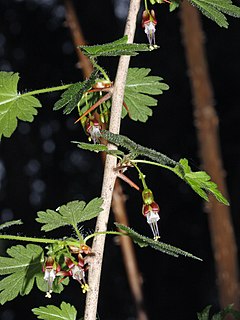
Gooseberry Hill National Park is a national park in Western Australia, in the locality of Gooseberry Hill, 21 km east of Perth. It is at the southern side of the mouth of the Helena Valley on the Darling Scarp. Statham's Quarry is located within the park boundary.

The gooseberry, with scientific names Ribes uva-crispa, is a species of Ribes.

Ribes is a genus of about 150 known species of flowering plants native throughout the temperate regions of the Northern Hemisphere. It is usually treated as the only genus in the family Grossulariaceae, but a few taxonomists place the gooseberry species in a separate genus of Grossularia.
Sometimes Ribes is instead included in the family Saxifragaceae.

Physalis is a genus of flowering plants in the nightshade family (Solanaceae), which grow in warm temperate and subtropical regions of the world. Most of the species, of which there may be 75–90, are indigenous to the Americas. Cultivated species and weedy annuals have been introduced worldwide. A notable feature is the formation of a large papery husk derived from the calyx, which partly or fully encloses the fruit. The fruit is small and orange, similar in size, shape and structure to a small tomato.

Physalis peruviana, a plant species of the genus Physalis in the nightshade family Solanaceae, has its origin in Peru. The plant and its fruit are commonly called Cape gooseberry, goldenberry, poha, and physalis, among numerous regional names. It has been cultivated in England since the late 18th century, and in South Africa in the Cape of Good Hope since at least the start of the 19th century. Widely introduced in the 20th century, P. peruviana is cultivated or grows wild across the world in temperate and tropical regions.

Phyllanthus emblica, also known as emblic, emblic myrobalan, myrobalan, Indian gooseberry, Malacca tree, or amla from Sanskrit amalaki is a deciduous tree of the family Phyllanthaceae. It has edible fruit, referred to by the same name.

Horseneck Beach State Reservation is a public recreation area comprising more than 800 acres (320 ha) on the Atlantic Ocean in the southern portion of the town of Westport, Massachusetts. The reservation is one of the state’s "most popular facilities ... welcom[ing] hundreds of thousands of visitors per year." It is managed by the Massachusetts Department of Conservation and Recreation.

Gooseberry Falls State Park is a state park of Minnesota, United States, on the North Shore of Lake Superior. The park is located in Silver Creek Township, about 13 miles (21 km) northeast of Two Harbors, Minnesota in Lake County on scenic Minnesota Highway 61. The park surrounds the mouth of the Gooseberry River and includes Upper, Middle and Lower Gooseberry Falls.

Gooseberry Hill is a suburb of Perth, Western Australia, located within the City of Kalamunda. It is the site of Gooseberry Hill National Park.

A fool is an English dessert. Traditionally, fruit fool is made by folding pureed stewed fruit into sweet custard. Modern fool recipes often skip the traditional custard and use whipped cream. Additionally, a flavouring agent like rose water may be added.

Actinidia deliciosa, fuzzy kiwifruit or mangüeyo is a fruiting vine native to southern China, the fruit of which has been declared the national fruit of that country. Other species of Actinidia are also found in China and range east to Japan and north into southern areas of Russian Far East. This species grows naturally at altitudes between 600 and 2,000 m.

Ribes divaricatum is a species in the genus Ribes found in the forests, woodlands, and coastal scrub of western North America from British Columbia to California. The three accepted varieties have various common names which include the word "gooseberry".

Hudson's Bay is a 1941 American historical drama film directed by Irving Pichel and starring Paul Muni, Gene Tierney, Laird Cregar and Vincent Price. Produced by 20th Century Fox, the film is about a pair of French-Canadian explorers whose findings lead to the formation of the Hudson's Bay Company.

Gooseberry River is a 23-mile stream in Lake County, Minnesota, USA, draining into Lake Superior. It is known for its waterfalls, near its mouth in Gooseberry Falls State Park. The Gooseberry, like many of its neighboring streams, has an irregular discharge highly dependent on runoff from rain and snow melt. The region around the river was heavily forested and much logging took place during the early 20th century. The forest has since regrown and the falls and mouth of the river are now a thriving tourist destination.

Gooseberry Island is a small, historical island off the coast of Westport in Bristol County, Massachusetts, United States. The island is a part of Westport, and is the town's most southern point.
Division No. 1, Subdivision C is an unorganized subdivision on the Avalon Peninsula in Newfoundland and Labrador, Canada. It is in Division 1 and contains the unincorporated communities of Cape St. Mary's, Cuslett, Gooseberry Cove, Great Barasway, Lears Cove, Patrick's Cove-Angels Cove, Ship Cove and Stoney House.

Gooseberry is an unincorporated community in Morrow County, Oregon, United States. Gooseberry lies along Ione–Gooseberry Road near its intersection with Oregon Route 206 between Heppner to the east and Condon to the west.

"Gooseberries" is an 1898 short story by Anton Chekhov, the second one in what has later become known as 'The Little Trilogy', along with "The Man in the Case" and "About Love".

















